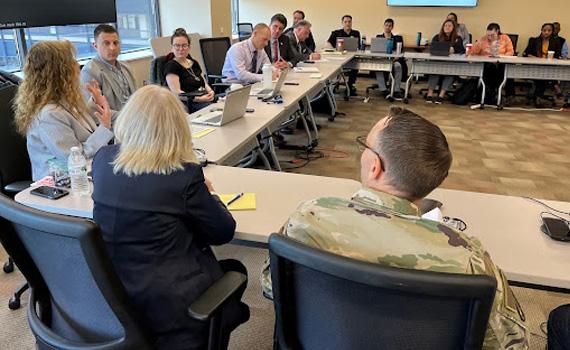Federal agencies huddle on disaster logistics

On April 12, multiple federal agencies came together to discuss how we work together during disasters to identify, procure, and transport life-saving resources during disasters. The Defense Logistics Agency (DLA), Federal Emergency Management Agency (FEMA), General Services Administration (GSA) and U.S. Army Corps of Engineers (USACE) met at FEMA’s regional office to discuss each agency’s mission, responsibilities, and capabilities during a disaster in preparation for hurricane season.
This event is unique across the country, with the Mid-Atlantic being the only region who hosts this kind of event. Participants included regional and national representatives, those with extensive experience and those new to their roles. Attendees discussed resource coordination, such as during the pandemic when agencies were often trying to source critical supplies from wherever possible, and working towards collaboration and cooperation for logistics support and timely delivery of resources where most needed.
The highlight for the event was a moderated panel discussion on coordinating the procurement of life saving resources and the response to recent crises, including the Afghan repatriation mission Operation Allies Welcome, Hurricane Ida, and the COVID-19 pandemic.
“The nation’s ability to address emergent threats is rooted in the strength of our emergency management workforce, partnerships, and interconnectivity,” said MaryAnn Tierney, Regional Administrator for FEMA Region 3. “Our capacity to prepare for, respond to, and recover from a crisis is exponentially increased when these partnerships are strong. It takes all of us working together to meet the needs of our nation.”
“The team of Region III federal partners exceeded the original intent of this engagement. The cross talk was robust and demonstrated the commitment to improving how we collectively respond both in blue and grey skies,” said Dorothy O’Connell, Whole of Government Division Chief for DLA Troop Support. “This commitment to partnership should be the model for all regions. What’s next? The next partnership summit will be expanded to other federal partners in the region.”
“This session highlights how each of us has a role to play in emergencies,” said Kathy Peek, GSA’s Regional Emergency Coordinator. “By talking now, we’re setting ourselves up for success when a real emergency happens and we need to help each other out.”
“It’s important to coordinate and develop awareness on emergency response capabilities before a disaster hits so these sessions are valuable,” said USACE Philadelphia District Chief of Emergency Management Jim Monsu. “We’re grateful to have strong partnerships with other federal entities in the Philadelphia and Mid-Atlantic region.”
Additional feedback noted that simultaneously seeking resources from a limited number of vendors during a disaster results in duplicate (or triplicate) effort and creates an artificial demand that can drive up prices. Although the group’s participants were regionally aligned, the challenge being addressed is one that extends beyond the Mid-Atlantic region and involves state, county, and local responders as well as federal. By focusing on collaboration in an emergency, each agency is able to deliver on their mission and meet the needs of survivors while reducing competition for scarce resources.
DLA, FEMA, GSA and USACE meet quarterly to review their mission assignments under disaster response and recovery, recap lessons learned from past events and build partnerships.
For more information, please visit:
https://www.fema.gov/about/organization/region-3
https://www.dla.mil/Troop-Support/About/
https://www.nap.usace.army.mil/Missions/Emergency-Management/
Public Affairs Officer
Leonard Buchanan
267-290-2864
leonard.buchanan@gsa.gov

 U.S. General Services Administration
U.S. General Services Administration